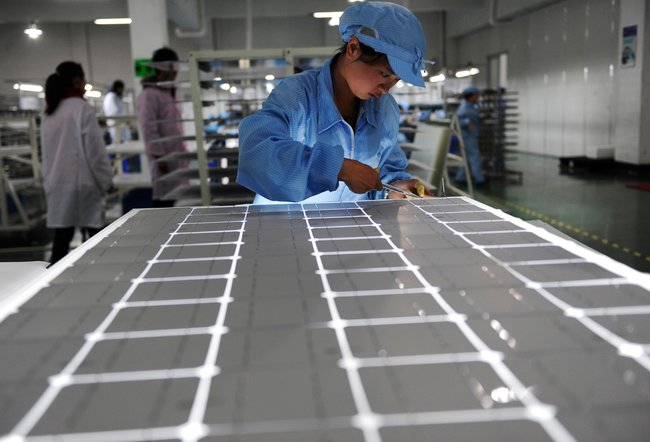U.S. Will Place Tariffs on Chinese Solar Panels
For one of the biggest panel makers, Suntech, the duties are slightly higher, moving to almost 36 percent from about 34 percent.
The trade case stemmed from a legal filing nearly a year ago by a coalition of manufacturers, led by SolarWorld, a German company with considerable manufacturing in the United States. The coalition contended that Chinese companies, which dominate global sales with a two-thirds market share, were competing unfairly in the American market.
“This is another important step in returning the solar marketplace in the United States to fair competition,” said Timothy C. Brightbill, a lawyer representing the companies that brought the case.
At the same time, Mr. Brightbill said, he was concerned that the Commerce Department did not expand the scope of the ruling, which applies to panels made up of Chinese-produced solar cells. That has allowed companies to sidestep the duties by assembling panels composed of cells produced elsewhere, even if their components come from China. “We are looking to the administration for an explanation on how they will close or address this loophole in the scope.”
The Chinese government had no immediate response to the decision, which was issued in the early hours of the morning Beijing time.
Some opponents of the tariffs said the ruling might not benefit the struggling United States manufacturers as much as SolarWorld and its supporters had hoped, given that Chinese firms could still make panels with cells produced in other countries.
“The fact that the Department of Commerce didn’t expand the scope means that those companies aren’t going to be banned from doing business in the U.S.,” said Jigar Shah, an entrepreneur representing a group of companies that opposed the tariffs. “We really think the Department of Commerce came down on the side of free trade.”
Shayle Kann, the head of GTM Research, a unit of Greentech Media, agreed. “There’s an impact there, but it’s not huge in terms of what it does to the market,” he said.
Wholesale prices have declined by nearly three-quarters since 2008 as Chinese companies expanded capacity and production much faster than the growth in worldwide demand. When China began the rapid expansion of its solar industry several years ago, many in the global industry expected that further technological breakthroughs would result in additional cost reductions.
But Chinese companies have driven costs down mainly through greater economies of scale from building ever-larger factories to produce conventional solar panels.
About a dozen panel makers in the United States, as well as a similar number in Europe, have gone bankrupt or closed factories since the start of last year. The European Union began the world’s largest antidumping case, covering solar panel imports from China that totaled $26.5 billion last year. The trade case has divided the American solar industry, with some manufacturers and installers siding with SolarWorld and others strongly opposing the tariffs.
The opponents argue that the duties would make it more expensive for American families and companies to install solar systems.
American manufacturers of factory equipment and raw materials have also expressed concern that the trade measures could imperil their sales to China, whose government began its own investigation into whether American and South Korean manufacturers of polysilicon, the main ingredient in the solar panels, were selling the material below cost.
Steve Ostrenga, chief executive of the panel maker Helios Solar Works USA of Milwaukee, who supported the trade case, said in a statement after Wednesday’s ruling that he was confident “that American manufacturers can compete with China on an equal footing.”
“Assuming an adequate response from the Obama administration on enforcement, we have some hope that there will continue to be a viable solar manufacturing base in the United States,” Mr. Ostrenga said.
Although the Commerce Department’s decision is final, the tariffs cannot go into effect unless the International Trade Commission finds that the Chinese pricing practices have actually harmed or threatened to harm the American industry, a determination that is not expected until November. But the commission issued a preliminary ruling that such injury had occurred, and reversals are uncommon, particularly if the domestic industry is in trouble.
The Commerce Department calculated separate penalties for unfair subsidies and dumping, reducing the antidumping penalties from the preliminary ruling for most of the manufacturers while sharply increasing the antisubsidy duties after finding that companies had benefited from additional subsidies.
But to avoid double-counting duties, the department reduced the rates importers will have to pay.
———-
This article has been revised to reflect the following correction:
Correction: October 10, 2012
A Breaking News headline posted online in advance of this article misstated the range of tariffs, and an earlier version of the article referred to the range imprecisely. It is 24 percent to 36 percent, not 31 percent to 47 percent, on most manufacturers of solar panels and cells imported from China.




A must watch on Job creation! Please “share” this! Tax cuts, no matter who gets them won’t spur the economy. Offshore business gets welfare from US and China! Why D or R won’t create one American job: Click my name above and can’t beg enough for you to share, if you love America greater than your Political Party.
Tariff on incoming goods only hurts us, the consumer! We need to end Offshore Corporate Welfare!